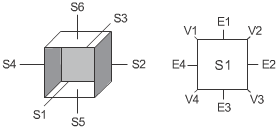Become familiar with the concepts of solid model data types to understand how geometric and topological data work together to form a complete model.
Surfaces contain the geometric data of a solid model. The geometric data describes the basic shape of an object and can be represented using NURBS ( Non-Uniform Rational B-Splines).
Loops, edges, and vertices contain the topological relationships between the individual surfaces that form the solid model. Topological data describes how the geometric components are connected together. In solid modeling terminology, surfaces are called faces, and each face is made up of loops, edges, and vertices.
The following is an example of a solid model of a cube which has six surfaces (faces) labeled S1 to S6 which form the geometrical and topological information required to define it as a solid model. Each of the surfaces has a loop set, but in this case each surface has only one loop. The loop for S1 has four edges and four vertices.

The edges are used to connect two loops from adjacent surfaces. The vertices are used to connect two or more edges.
This solid box consists of six surfaces, twelve edges, and eight vertices that form the geometrical and topological information required to define it as a solid model. For example, if a hole is placed in the box through S1 and S6, S1 and S6 would each have a loop set containing two loops.